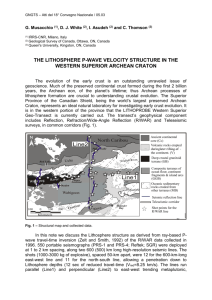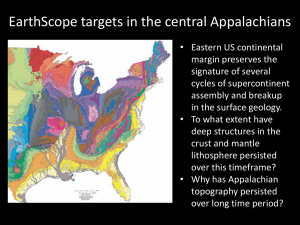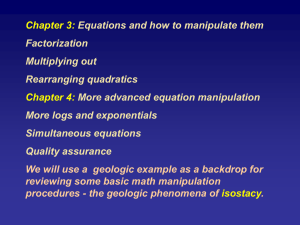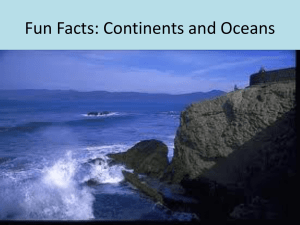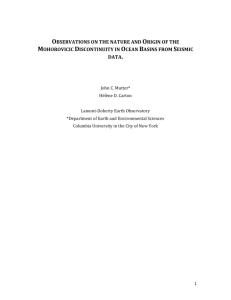Moho comparison
advertisement
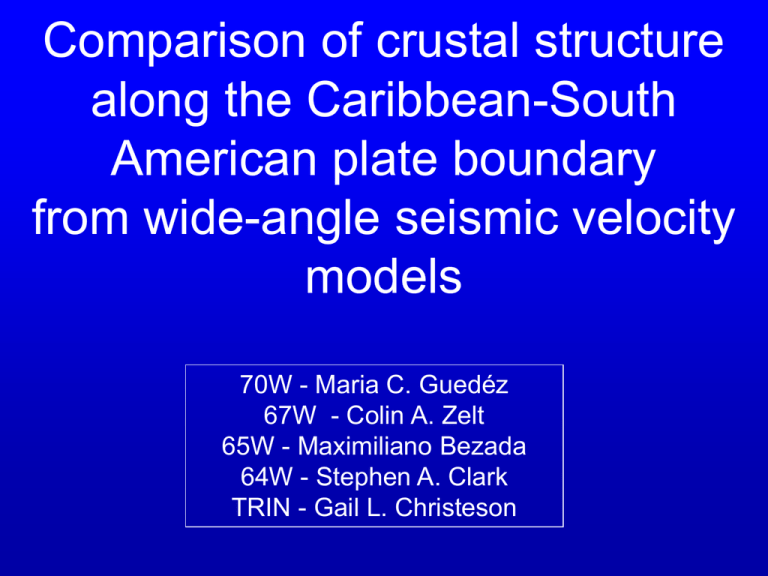
Comparison of crustal structure along the Caribbean-South American plate boundary from wide-angle seismic velocity models 70W - Maria C. Guedéz 67W - Colin A. Zelt 65W - Maximiliano Bezada 64W - Stephen A. Clark TRIN - Gail L. Christeson TRIN 64W 65W 67W 70W Crustal structure domains Five wide-angle profiles on regional gravity map with seven crustal structure domains trending roughly east-west from (1) in the north representing the Venezuela Basin, to (7) in the south representing the South American continent. The domains are not tectonic provinces, although they resemble those defined by Mann (1999). 5 velocity models 5 wide-angle velocity profiles arranged from west (top) to east (bottom). Each model was obtained by a combination of first-arrival tomography to derive upper/middle crust, and joint PmP and Pn inversion to derive lower crust, Moho and upper mantle. The boundaries of the crustal structure domains are indicated by dashed lines; each domain is numbered 1 through 7. Corresponding average velocity-depth functions in each domain for each wide-angle profile has been calculated. The Oca-San Sebastian-El Pilar strike-slip fault indicated by thick gray dashed line. 1. Venezuela Basin All of the profiles, except 67W, sample oceanic plateau crust in the north with Moho depths of 19-27 km. Profile 67W shows close to normal oceanic crust. 2. South Caribbean Deformed Belt The 3 western profiles image the SCDB which consists of a thick sedimentary wedge. Profile 67W’s crustal thickness is less due to normal oceanic crust versus plateau crust. 3. Leeward Antilles and Aves Ridge The Aves Ridge and Leeward Antilles Arc are very similar in terms of velocity and crustal thickness, except profile 70W in the west shows much thicker crust. 4. Bonaire and Grenada Basins The Grenada Basin along TRIN and 64W are very different, likely because 64W samples the very edge. However, the basins along 64W and 70W appear very similar, as do those along 65W and 67W. 5. Falcon and Bonaire Basins, Margarita High and Lesser Antilles The Lesser Antilles and Margarita High along TRIN, 64W and 65W are quite different. The Bonarie and Falcon Basins along 67W and 70W are very different. 6. Cariaco, Araya and Tobago Basins These three basins along TRIN, 64W and 65W appear quite different. 7. South American continent The South American continent appears quite similar along the four onshore profiles, except profile 64W shows much thicker crust. Comparison of Caribbean arc profiles Aves and Leeward Antilles Arcs are very similar (except along 70W), and the Lesser Antilles (TRIN) and Margarita High (65W) are somewhat similar to these arcs, but the Margarita High along 64W is very different from all the rest. Comparison of average Caribbean arc and S.A. continent with global continent average Comparison of average Caribbean arc crust (domains 3 & 5) and average South American continent crust (domain 7) with global continent average (Christensen & Mooney 1995). Between 5 and 25 km depth, the arc crust is consistently ~0.25 km/s faster than the S.A. continent, but similar to the global average. The S.A. continent is consistently slower than the global average to 35 km depth. [Note that the average arc and S.A. continent profiles below 25 km and 35 km, respectively, are not very meaningful because of the way in which the lateral averages were calculated without regard to the Moho depth.] 7:1 Moho comparison Comparison of Mohos with zero distance corresponding to 12oN, a vertical exaggeration of 7, and offset from each other for clarity. Generally, the Moho contains steeper segments in the east. 1:1 Moho comparison Comparison of the 5 Mohos aligned at the position of the major strike-slip fault, with a vertical exaggeration of one, and offset from each other for clarity. 2:1 Moho comparison Comparison of the 5 Mohos aligned at the position of the major strike-slip fault, with a vertical exaggeration of 2, and offset from each other for clarity. Conclusions - part 1 (1). Thick oceanic plateau crust exists at the north end of all profiles, except 67W; thick sedimentary wedge (the South Caribbean Deformed Belt) present along the western 3 profiles. (2). The Aves Ridge and Leeward Antilles Arc are very similar in terms of velocity and crustal thickness. (3) The Lesser Antilles and Margarita High are quite different. In addition, the Bonarie and Falcon Basins are very different; the Leeward/Aves and Lesser Antilles are somewhat similar. (4) The South American continent is quite homogeneous in terms of velocity and crustal thickness, except it is ~8 km thicker along profile 64W. (5) The average Caribbean arc crust is consistently ~0.25 km/s faster than the S.A. continent, but similar to the global average (consistent with Yemi’s 3D model); the South American continent is consistently slower than the global average. (6) The Moho has steeper segments in the east compared to the west. Conclusions - part 2 (1) strong support for continuity of the Aves and Leeward Antilles Arc based on velocity and crustal thickness. (2) high crustal velocities at all depths within the arcs compared to the adjacent South American continent. (3) a general smoothing and flattening of Moho topography from the youngest to oldest parts of the margin (east to west), suggesting a “relaxation” of the Moho. Moho comparison Comparison of Mohos with zero distance corresponding to 12oN, and a vertical exaggeration of 7. Generally, the Moho contains steeper segments in the east (TRIN and 64W) and is smoother to the west.
